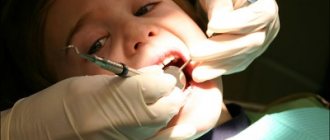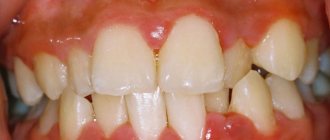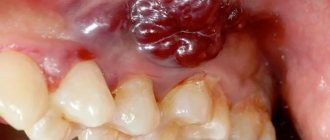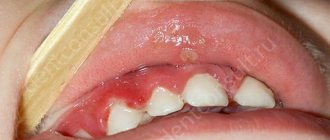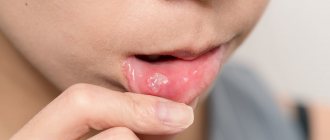Ball in mouth - what is it?
When the inflammation begins to gradually progress, a blister appears on the gum. The main reason for the formation of a lump is poor oral hygiene and prevention. But the ball can also form under the influence of other factors: inflammation occurring in the roots of the teeth, gums, mucous membranes, and periosteum.
The problem is that the disease can be diagnosed in the later stages, with the development of a purulent process. This happens because the patient does not visit the dentist. For patients who experience fear while in a chair, the doctor can give sedative anesthesia, in which the receptors are turned off and the patient falls into a shallow sleep.
Attention! It is better to diagnose the disease early in order to prevent more dangerous consequences, including blood infection and inflammation of the entire jaw.
Diagnosis of atheroma on the face
Atheroma looks like a small subcutaneous ball. The tumor itself does not resolve and gradually increases. With long-term existence, atheroma on the face can reach 7 cm in diameter. On its surface you can always see a black dot that blocks the sebaceous duct. Atheroma has clear boundaries and a spherical shape. The patient does not feel pain upon palpation. Visually, atheroma is similar to lipoma, hygroma, fibroma, hemangioma, so a doctor must make an accurate diagnosis. If there are difficulties in diagnosis, an MRI may be prescribed to determine the nature of the tumor. After removal of any formation, including atheroma, a histological examination is carried out.
Rice. 2 Atheroma looks like a small ball under the skin of the face
Why does a lump appear on the gum?
The accumulation of conditionally pathogenic and pathogenic microflora due to improper oral care leads to inflammation of the mucous membrane. Other reasons why a ball appears on the gum include:
- chemical, thermal or mechanical trauma to the periodontium;
- carious formations and their complications: periodontitis, pulpitis;
- inflammation of the wisdom tooth;
- eruption of molars;
- jawbone overgrowth;
- weak immune system;
- infectious pathologies of the oral cavity: herpes, candidiasis, stomatitis.
A lump in the mouth also occurs under other conditions: epulis, exostosis, fibroma, focal fibromatosis, malignancy, cyst and flux. The main thing is to promptly establish the causes of the pathology and begin treatment.
Treatments for bumps on the chin
The course of treatment is developed by the doctor, depending on what caused the formation of a ball on the chin. If the internal lump is a boil, the doctor prescribes antibacterial alcohol products for external use and a complex of supporting vitamins. Internal pimple resolves without treatment. To eliminate a lump caused by inflammation of the oral cavity, it is necessary to treat the root cause. To do this, the patient is referred to a dentist, who identifies and treats the problem. This is done conservatively, that is, with the help of medications or surgically. Surgical treatment is also prescribed for lipomas and cancers. In modern clinics, a procedure is available for removing tumors and lipomas from the chin using a laser. This method causes less pain and does not require surgery.
Medicines
Two types of medications are used in the treatment of lumps on the chin. Preparations for internal and external use. Antimicrobial therapy uses drugs with antiseptic properties and is sold without a prescription. In the group of antiseptics:
- "Chlorhexidine";
- "Streptocide";
- "Skinoren";
- tar soap;
- "Badyaga";
- infusion of celandine;
- salicylic acid.
As a rule, bumps on the chin are eliminated with ointments or infusions.
There are external preparations that counteract the blockage of the sebaceous glands and slow down cell division, for example, Differin or Adapalene. In case of infection, it is more effective to use drugs with internal influence. A popular antibiotic drug that is prescribed when a lump appears on the chin is Doxycycline. Prescribing antibiotics has virtually no contraindications, but uncontrolled use of such drugs leads to a number of side effects. Among which are allergic reactions, dysbiosis and digestive disorders.
Patients are prescribed hormonal drugs. This occurs in cases of hormonal changes; they are most often prescribed to women. Hormonal drugs are available in various medical forms, in tablets, ointments or injection ampoules. Medicines containing retinol are gaining popularity. They are called retinoids. Retinol is vitamin A, which affects the quality of epithelial cells (melanin). This vitamin has a positive effect on the condition of the skin, hair and nails. Therefore, it is prescribed for both therapy and prevention. Preparations that contain vitamin A:
- "Retin A";
- "Lokacid";
- "Acitretin."
Folk remedies
Home treatment methods are used in combination with drug therapy to achieve the best effect. Recipes for traditional methods include decoctions, infusions and plant extracts. Therefore, home remedies have few contraindications. Aloe juice is considered an effective remedy, from which a compress is made on the problem area. Herbal tea is also effective in healing and includes plantain, eucalyptus and nettle.
If the ball in your mouth does not cause discomfort
The color of the bubble will help the doctor make a diagnosis. A white lump on the gum indicates the presence of exostosis or purulent exudate. A red or bloody ball indicates the development of inflammation. If the growth matches the shade of the tissue, it is the initial stage of epulis, flux, or a malignant tumor. When the tumor does not hurt, this indicates the presence of one of the pathologies:
A fistula is a white ball on soft tissues that appears under or on a tooth. There is a hole on the surface for the release of pus. If, when pressed, suppuration flows out of the bladder, the patient does not feel pain. If the hole is closed with pus or bloody clots, the patient will experience discomfort with any impact.
A fistula is often formed due to advanced periodontitis, accompanied by periodontal hyperplasia. Overgrown tissue is good soil for the proliferation of microorganisms. In this case, the patient urgently needs treatment for periodontitis.
In the absence of therapy, the fistula enters a chronic stage, which can only be eliminated through surgical treatment. The progression of the disease must not be allowed, otherwise you may lose healthy molars.
Hematoma is a round lump on the inner surface of the cheek. Sometimes it occurs in the form of a dark bluish swelling on top of the gums. Blood accumulates in or around the root of the molar. The mucous membrane grows, the patient experiences discomfort and cannot completely close the jaw. The main reasons: consequences of filling or tooth extraction, gum damage, poor blood clotting.
Hematomas are generally not dangerous. Processes take place in the body through which soft tissues are cleared of bloody clots. After some time, the bubble disappears, but if the seal remains, you need to visit a dental clinic.
Exostosis is a hard blister that is an abnormality in which the bones protrude and protrude from the jaw. Gradually, the lump increases in volume, which causes discomfort and pain. Exostosis can be provoked by various reasons:
- jaw damage;
- heredity;
- congenital disorders;
- tissue diseases after molar removal.
An examination by a dentist or an x-ray will help detect the disease. The formation will need to be removed if the development of a malignant tumor is suspected.
Epulis is a pedunculated bubble in the form of a mushroom-shaped growth on the periodontium. The tumor may be the same color as the gums or red. The reasons causing the development of pathology include:
- improper filling of the molar or too large a filling;
- dental plaque, stone;
- jaw damage;
- malocclusion;
- hormonal imbalance;
- poor prosthetic material or incorrect prosthetics.
The symptoms of epulis resemble gingivitis; for diagnosis, the dentist prescribes radiography and histology to the patient. With their help, the degree of destruction of bone tissue at the site of the epulis lesion is determined. Mostly, pathology occurs in children during the growth of primary molars and in women.
Papilloma or fibroma is a bubble on the gum, sometimes a benign formation that does not pose a threat to the health or life of the patient. They are formed in people of different genders and ages. Predisposing factors to the appearance of a lump can be: damage to the mucosa, stress, systemic pathologies, heredity.
Papilloma is an enlargement of the papillary layer of skin. The bubble grows gradually, but with reduced immunity, systemic pathology, or stress, growth accelerates, but without turning into a malignant tumor. A papilloma neoplasm looks like a smooth, soft lump on the mucous membrane of a white or pink shade on a thin stalk.
Papilloma often does not create any discomfort. But after some time it may increase in size. You should consult a dentist and get tested.
Diagnostic method
A neoplasm can be diagnosed, even in the absence of symptoms and pain, using MRI of the soft tissues of the cervical spine.
The examination will reveal the formation, determine the size, as well as connections with other vessels, tissues and organs. As for choosing a doctor, it directly depends on the type of lump. If the diagnosis shows enlarged lymph nodes, then it is advisable to consult a therapist. The doctor will determine the reason why the lump on the neck is growing and give recommendations for treatment.
Since the appearance of a cyst on the neck is often a consequence of tonsillitis, advanced caries or sore throat, you will need to consult an otolaryngologist and dentist. A dermatologist will give recommendations on the safe performance of cosmetic surgeries and the treatment of skin diseases.
If a malignant neoplasm is suspected, the therapist will refer you to an oncologist. If a formation is diagnosed that cannot be treated with medication, but is removed, they are referred to a surgeon.
When visiting a doctor, the patient initially undergoes a visual examination, after which the doctor will make an accurate diagnosis and prescribe treatment. To determine the full clinical picture, you will be referred for additional examinations (computer and magnetic resonance imaging, ultrasound, blood tests, etc.).
Also, if a malignant tumor is suspected, the doctor will prescribe a biopsy of the affected tissue for histological examination of the samples.
If the formation on the gum causes discomfort
If a bubble near a molar causes pain, this indicates an infectious inflammatory process. Discomfort is also typical with gum injuries and hematomas. Painful formations can be caused by a cyst, cancer, fibroma, periostitis, periodontitis.
Gingivitis - the disease affects only one gum, and the periodontium near the molar remains uninjured. The main symptoms of the pathology are swelling, bleeding, and peeling of the epithelium. Gingivitis often occurs against the background of halitosis. Sometimes pathology develops as a result of endocrine and metabolic disorders.
When treating, it is necessary to eliminate the cause of gingivitis. Professional oral hygiene, diagnosis and treatment of metabolic disorders are performed. To eliminate inflammation and prevent further spread of bacteria, antibiotic therapy is administered. For pain and severe discomfort, analgesics are prescribed.
Periodontitis - purulent bumps on the gums appear as a result of degeneration of the alveolar process, through which the tooth root is held in the alveolus. Tissues can be destroyed due to poor oral hygiene and internal pathologies.
In the initial stages, periodontitis is treated by teeth cleaning at the dental clinic and further proper care. An advanced form of the disease, in which the teeth become loose, pus accumulates, requires surgical intervention - restoration of the alveolar processes or removal of molars.
Periostitis or flux is a dense formation near a problematic molar with carious lesions. Patients complain of pain radiating to the temple, chest, neck, ear. The condition gradually worsens and the temperature can rise to 38 degrees. In the oral cavity, lesions due to periostitis are hyperemic. A purulent fistula forms. When the discharge is removed, the discomfort decreases.
Causes of periostitis: trauma, periodontitis, osteomyelitis, weak immune system, infectious pathologies occurring in the body and vitamin deficiency.
What are cysts?
A cyst is a pathological cavity in the tissues, which has dense walls and thick contents. The fusion of cysts and penetration into foci of infection leads to compaction of the formations, and sometimes to infiltration and abscess formation.
With cystic acne, areas of severe inflammation form. The cysts fill with pus, and pressing on them causes pain. Cystic elements are easily squeezed out, but this should not be done, as this can lead to tissue scarring.
Nodular cystic acne refers to a severe form of acne. Most often this happens if the disease is advanced and there was no timely treatment. The chronic inflammatory process provokes the formation of nodules with a diameter of more than 1 cm, which merge with cysts and other types of rash. In this case, the disease affects the deep layers of the dermis.
Treatment of neoplasms in the oral cavity
A lump under the jaw or on the gum can be detected upon examination. For an accurate diagnosis, a biopsy or x-ray is prescribed. Treatment is selected taking into account the cause of the formation of a bubble in the oral cavity. It will be necessary to stop the further spread of infection and eliminate discomfort.
The doctor will determine how to remove the lump after a complete diagnosis, but the main measures include:
- fistula - pus is removed by rinsing with a disinfectant solution;
- epulis - surgical intervention (removal using diathermocoagulation, cryodestruction or a scalpel);
- periodontitis - removing fillings, cleaning canals, removing pus, rinsing with herbal decoctions and soda solution;
- periostitis - placement of special drugs under a temporary filling (if there is no result, the tooth will have to be removed);
- gingivitis - cleaning of periodontal tubules, antiseptic and antibacterial therapy, removal of lumps.
When a formation appears on the gum, you can rinse your mouth with vodka, diluted alcohol or juice from fresh Kalanchoe leaves.
Timely diagnosis allows you to prevent further spread of infection and save teeth.
Only an experienced dentist will help you get rid of a lump in your mouth, minimizing the risk of developing serious complications. At the first signs of pathology, you should immediately consult a doctor. The doctor's consultation

